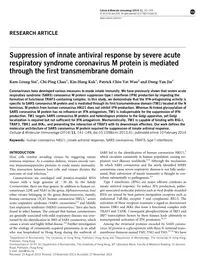
2014 Suppression of innate antiviral response by severe acute respiratory syndrome coronavirus M protein is mediated thr PDF
Preview 2014 Suppression of innate antiviral response by severe acute respiratory syndrome coronavirus M protein is mediated thr
RESEARCH ARTICLE Suppression of innate antiviral response by severe acute respiratory syndrome coronavirus M protein is mediated through the first transmembrane domain Kam-Leung Siu1, Chi-Ping Chan1, Kin-Hang Kok1, Patrick Chiu-Yat Woo2 and Dong-Yan Jin1 Coronaviruses have developed various measures to evade innate immunity. We have previously shown that severe acute respiratory syndrome (SARS) coronavirus M protein suppresses type I interferon (IFN) production by impeding the formation of functional TRAF3-containing complex. In this study, we demonstrate that the IFN-antagonizing activity is specific to SARS coronavirus M protein and is mediated through its first transmembrane domain (TM1) located at the N terminus. M protein from human coronavirus HKU1 does not inhibit IFN production. Whereas N-linked glycosylation of SARS coronavirus M protein has no influence on IFN antagonism, TM1 is indispensable for the suppression of IFN production. TM1 targets SARS coronavirus M protein and heterologous proteins to the Golgi apparatus, yet Golgi localization is required but not sufficient for IFN antagonism. Mechanistically, TM1 is capable of binding with RIG-I, TRAF3, TBK1 and IKKe, and preventing the interaction of TRAF3 with its downstream effectors. Our work defines the molecular architecture of SARS coronavirus M protein required for suppression of innate antiviral response. Cellular & Molecular Immunology (2014) 11, 141–149; doi:10.1038/cmi.2013.61; published online 10 February 2014 Keywords: human coronavirus HKU1; innate antiviral response; SARS coronavirus; TRAF3; type I interferons INTRODUCTION Host cells combat invading viruses by triggering innate immune response. As a counter-defense, viruses encode vari- ous immunosuppressive proteins to evade innate immunity. This interaction between host cells and viruses dictates the outcome of viral infection.1 Coronaviruses are enveloped and positive-stranded RNA viruses with a large genome of ,30 kb. In the family Coronaviridae, there are four genera. In addition to human co- ronaviruses 229E and NL63 in the genus Alphacoronavirus, four other viruses belonging to the genus Betacoronavirus, namely, human coronavirus OC43, human coronavirus HKU1,2 severe acute respiratory syndrome (SARS) coronavirus3,4 and Middle East respiratory syndrome (MERS) coronavirus,5 have also been found to infect human. The concept that human coronaviruses are generally associated with mild respiratory diseases was over- turned by the identification in 2003 of SARS coronavirus, which causes a severe and highly lethal disease.3,4 Further investigation of the etiology of community-acquired pneumonia in an adult who was hospitalized in Hong Kong during the outbreak of SARS led to the identification of human coronavirus HKU1,2 which circulates commonly in human population causing res- piratory tract illnesses worldwide.6–8 Although the mechanism by which SARS coronavirus and the newly identified MERS coronavirus cause severe respiratory diseases is not fully under- stood, their subversion of innate immunity is thought to con- tribute substantially to pathogenesis.4,9 Type I interferons (IFNs) are major effector cytokines in innate antiviral response. To induce IFN production, patho- gen-associated molecular patterns such as viral double-stranded RNA are sensed by host pattern recognition receptors such as endosomal Toll-like receptor 3 and cytoplasmic RIG-I. The activation of these receptors transmits a signal to downstream kinases TBK1 and IKKe that form a functional complex with TRAF3 and TANK. Consequent phosphorylation of IRF3 and IRF7 transcription factors by these kinases leads ultimately to transcriptional activation of IFN promoters.10,11 Among the structural proteins encoded by SARS corona- virus, M protein is a glycoprotein with three N-terminal trans- membrane domains named TM1, TM2 and TM3.12,13 We have 1Department of Biochemistry, The University of Hong Kong, Pokfulam, Hong Kong and 2Department of Microbiology, The University of Hong Kong, Pokfulam, Hong Kong Correspondence: Dr DY Jin, Department of Biochemistry, The University of Hong Kong, 3/F Laboratory Block, Faculty of Medicine Building, 21 Sassoon Road, Pokfulam, Hong Kong. E-mail:
